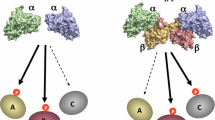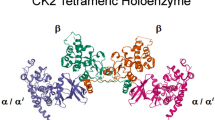Abstract
Breast cancer is a major cause of cancer death in women, and the genetic abnormalities leading to the common sporadic forms of the disease are still under active investigation. CK2 has been reported to be upregulated in human breast cancer, which these studies confirm; CK2 is also upregulated in rat carcinogen-induced breast tumors. Transgenic mice overexpressing CK2α in the mammary gland develop mammary hyperplasia, dysplasia, and eventually adenocarcinomas, demonstrating that dysregulated expression of CK2 can contribute to transformation of the mammary epithelium. These mammary tumors have evidence of activation of the Wnt and NFκB pathways and upregulation of c-Myc. CK2 is capable of phosphorylating the key signaling molecule in the Wnt pathway, the transcriptional cofactor β-catenin, and regulating its turnover. CK2 is known to phosphorylate IκB and thereby regulate basal NFκB levels; in the mammary cell lines and tumors, CK2 activity correlates with NFκB levels and inhibition of CK2 downregulates NFκB. Thus, CK2 may promote breast cancer through dysregulation of key pathways of transcriptional control in the mammary epithelium, and inhibition of CK2 has a potential role in the treatment of breast and other cancers.
Similar content being viewed by others
References
Xu X, Toselli PA, Russell LD, Seldin DC: Globozoospermia in mice lacking the casein kinase II alpha′ catalytic subunit. Nat Genet 23: 118–121, 1999
Seldin DC, Leder P: Casein kinase II alpha transgene-induced murine lymphoma: Relation to theileriosis in cattle. Science 267: 894–897, 1995
Kelliher MA, Seldin DC, Leder P: Tal-1 induces T cell acute lymphoblastic leukemia accelerated by casein kinase IIalpha. Embo J 15: 5160–5166, 1996
Landesman-Bollag E, Channavajhala PL, Cardiff RD, Seldin DC: p53 deficiency and misexpression of protein kinase CK2alpha collaborate in the development of thymic lymphomas in mice. Oncogene 16: 2965–2974, 1998
Allende JE, Allende CC: Protein kinases. 4. Protein kinase CK2: An enzyme with multiple substrates and a puzzling regulation. FASEB J 9: 313–323, 1995
Pinna LA, Meggio F: Protein kinase CK2 ('casein kinase-2') and its implication in cell division and proliferation. Prog Cell Cycle Res 3: 77–97, 1997
Kim DW, Sovak MA, Zanieski G, Nonet G, Romieu-Mourez R, Lau AW, Hafer LJ, Yaswen P, Stampfer M, Rogers AE, Russo J, Sonenshein GE: Activation of NF-kappaB/Rel occurs early during neoplastic transformation of mammary cells. Carcinogenesis 21: 871–879, 2000
Sinn E, Muller W, Pattengale P, Tepler I, Wallace R, Leder P: Coexpression of MMTV/v-Ha-ras and MMTV/c-myc genes in transgenic mice: Synergistic action of oncogenes in vivo. Cell 49: 465–475, 1987
http://www-mp.ucdavis.edu/tgmice/firststop.html
Kuenzel EA, Mulligan JA, Sommercorn J, Krebs EG: Substrate specificity determinants for casein kinase II as deduced from studies with synthetic peptides. J Biol Chem 262: 9136–9140, 1987
Duyao MP, Buckler AJ, Sonenshein GE: Interaction of an NF-kappa B-like factor with a site upstream of the c-myc promoter. Proc Natl Acad Sci U S A 87: 4727–4731, 1990
Arsura M, FitzGerald MJ, Fausto N, Sonenshein GE: Nuclear factor-kappaB/Rel blocks transforming growth factor beta1-induced apoptosis of murine hepatocyte cell lines. Cell Growth Differ 8: 1049–1059, 1997
Huggins C, Grand LC, Brillantes FP: Mammary cancer induced by a single feeding of polynuclear hydrocarbons, and its suppression. Nature 189: 204–207, 1961
Rogers, BH: Dimethylbenzanthracene-induced mammary tumorigenesis in ethanol-fed rats. Nutr Res 10: 143–146, 1990
Stewart TA, Pattengale PK, Leder P: Spontaneous mammary adenocarcinomas in transgenic mice that carry and express MTV/myc fusion genes. Cell 38: 627–637, 1984
Cardiff RD: The biology of mammary transgenes: Five rules. J Mammary Gland Biol Neoplas 1: 61–73, 1996
Mahler JF, Stokes W, Mann PC, Takaoka M, Maronpot RR: Spontaneous lesions in aging FVB/N mice. Toxicol Pathol 24: 710–716, 1996
Cardiff RD, Wellings SR: The comparative pathology of human and mouse mammary glands. J Mammary Gland Biol Neoplas 4: 105–122, 1999
Willert K, Brink M, Wodarz A, Varmus H, Nusse R: Casein kinase 2 associates with and phosphorylates dishevelled. Embo J 16: 3089–3096, 1997
Pando MP, Verma IM: Signal-dependent and-independent degradation of free and NF-kappa B-bound Ikappa Balpha. J Biol Chem 275: 21278–21286, 2000
Janosch P, Schellerer M, Seitz T, Reim P, Eulitz M, Brielmeier M, Kolch W, Sedivy JM, Mischak H: Characterization of IkappaB kinases. IkappaB-alpha is not phosphorylated by Raf-1 or protein kinase C isozymes, but is a casein kinase II substrate. J Biol Chem 271: 13868–13874, 1996
Schwarz EM, Van AD, Verma IM: Constitutive phosphorylation of IkappaBalpha by casein kinase II occurs preferentially at serine 293: Requirement for degradation of free IkappaBalpha. Mol Cell Biol 16: 3554–3559, 1996
McElhinny JA, Trushin SA, Bren GD, Chester N, Paya CV: Casein kinase II phosphorylates I kappa B alpha at S-283, S-289, S-293, and T-291 and is required for its degradation. Mol Cell Biol 16: 899–906, 1996
Foo SY, Nolan GP: NF-kappaB to the rescue: RELs, apoptosis and cellular transformation. Trends Genet 15: 229–235, 1999
Nakshatri H, Bhat-Nakshatri P, Martin DA, Goulet RJ Jr, Sledge GW Jr: Constitutive activation of NF-kappaB during progression of breast cancer to hormone-independent growth. Mol Cell Biol 17: 3629–3639, 1997
Romieu-Mourez R, Landesman-Bollag E, Seldin DC, Traish AM, Mercurio F, Sonenshein GE: Roles of IKK kinases and protein kinase CK2 in activation of NF-kB in breast cancer. Cancer Res (in press)
Sovak MA, Bellas RE, Kim DW, Zanieski GJ, Rogers AE, Traish AM, Sonenshein GE: Aberrant nuclear factor-kappaB/Rel expression and the pathogenesis of breast cancer. J Clin Invest 100: 2952–2960, 1997
Howard DK, Schlom J, Fisher PB: Chemical carcinogen-mouse mammary tumor virus interactions in cell transformation. In Vitro 19: 58–66, 1983
Kessler DJ, Duyao MP, Spicer DB, Sonenshein GE: NF-kappa B-like factors mediate interleukin 1 induction of c-myc gene transcription in fibroblasts. J Exp Med 176: 787–792, 1992
He TC, Sparks AB, Rago C, Hermeking H, Zawel L, da Costa LT, Morin PJ, Vogelstein B, Kinzler KW: Identification of c-MYC as a target of the APC pathway. Science 281: 1509–1512, 1998
Serres M, Grangeasse C, Haftek M, Durocher Y, Duclos B, Schmitt D: Hyperphosphorylation of beta-catenin on serine-threonine residues and loss of cell-cell contacts induced by calyculin A and okadaic acid in human epidermal cells. Exp Cell Res 231: 163–172, 1997
Agullo G, Gamet-Payrastre L, Manenti S, Viala C, Remesy C, Chap H, Payrastre B: Relationship between flavonoid structure and inhibition of phosphatidylinositol 3-kinase: A comparison with tyrosine kinase and protein kinase C inhibition. Biochem Pharmacol 53: 1649–1657, 1997
Munstermann U, Fritz G, Seitz G, Lu YP, Schneider HR, Issinger OG: Casein kinase II is elevated in solid human tumours and rapidly proliferating non-neoplastic tissue. Eur J Biochem 189: 251–257, 1990
Ohi Y, Yoshida H: Influence of estrogen and progesterone on the induction of mammary carcinomas by 7,12-dimethylbenz(a)anthracene in ovariectomized rats. Virchows Arch B Cell Pathol Incl Mol Pathol 62: 365–370, 1992
Tsukamoto AS, Grosschedl R, Guzman RC, Parslow T, Varmus HE: Expression of the int-1 gene in transgenic mice is associated with mammary gland hyperplasia and adenocarcinomas in male and female mice. Cell 55: 619–625, 1988
Barker N, Huls G, Korinek V, Clevers H: Restricted high level expression of Tcf-4 protein in intestinal and mammary gland epithelium. Am J Pathol 154: 29–35, 1999
Bui TD, Rankin J, Smith K, Huguet EL, Ruben S, Strachan T, Harris AL, Lindsay S: A novel human Wnt gene, WNT10B, maps to 12q13 and is expressed in human breast carcinomas. Oncogene 14: 1249–1253, 1997
Dale TC, Weber-Hall SJ, Smith K, Huguet EL, Jayatilake H, Gusterson BA, Shuttleworth G, O'Hare M, Harris AL: Compartment switching of WNT-2 expression in human breast tumors. Cancer Res 56: 4320–4323, 1996
Huguet EL, McMahon JA, McMahon AP, Bicknell R, Harris AL: Differential expression of human Wnt genes 2, 3, 4, and 7B in human breast cell lines and normal and disease states of human breast tissue. Cancer Res 54: 2615–2621, 1994
Israel A: The IKK complex: An integrator of all signals that activate NF-kappaB? Trends Cell Biol 10: 129–133, 2000
Bren GD, Pennington KN, Paya CV: PKC-zeta-associated CK2 participates in the turnover of free IkappaBalpha. J Mol Biol 297: 1245–1258, 2000
Heilker R, Freuler F, Pulfer R, Di Padova F, Eder J: All three IkappaB isoforms and most Rel family members are stably associated with the IkappaB kinase 1/2 complex. Eur J Biochem 259: 253–261, 1999
Tran K, Merika M, Thanos D: Distinct functional properties of IkappaB alpha and IkappaB beta. Mol Cell Biol 17: 5386–5399, 1997
Lin R, Beauparlant P, Makris C, Meloche S, Hiscott J: Phosphorylation of IkappaBalpha in the C-terminal PEST domain by casein kinase II affects intrinsic protein stability. Mol Cell Biol 16: 1401–1409, 1996
Bird TA, Schooley K, Dower SK, Hagen H, Virca GD: Activation of nuclear transcription factor NF-kappaB by interleukin-1 is accompanied by casein kinase II-mediated phosphorylation of the p65 subunit. J Biol Chem 272: 32606–32612, 1997
Author information
Authors and Affiliations
Corresponding author
Rights and permissions
About this article
Cite this article
Landesman-Bollag, E., Song, D.H., Romieu-Mourez, R. et al. Protein kinase CK2: Signaling and tumorigenesis in the mammary gland. Mol Cell Biochem 227, 153–165 (2001). https://doi.org/10.1023/A:1013108822847
Issue Date:
DOI: https://doi.org/10.1023/A:1013108822847




